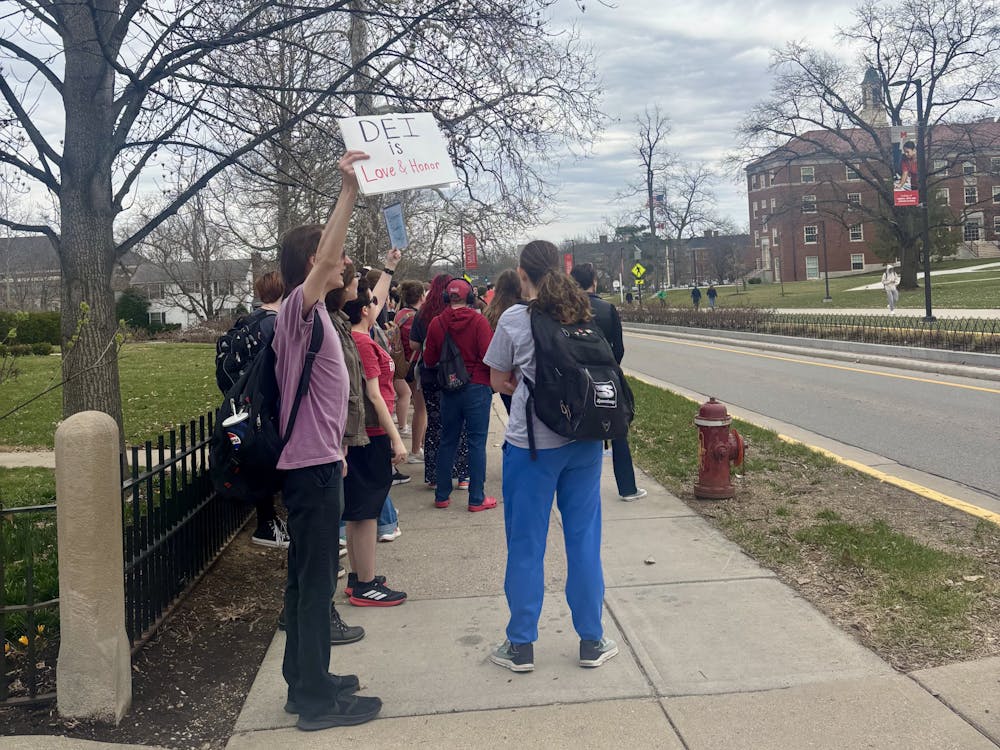The very first time that Class of 2020 Miami graduate Andrew Devedjian stepped foot into Armstrong Student Center during a 2016 campus visit, he immediately searched for the Armenian flag hanging among others on the wall.
He didn’t see it.
Throughout his next four years at Miami, Devedjian would continue to look for the flag each time he was passing through Armstrong but never found it.
Senior Sinait Sarfino also searched for a certain flag as she walked through Armstrong — the South Sudanese flag — but never found it, either. She realized that flags from numerous African nations were not on the wall, including those representing students she knew personally.
“I was like, ‘Well, I want to change that, so let’s get to work,’” she said.
Sarfino spoke with other students and found that her concerns were shared among numerous people who felt underrepresented. Devedjian had encountered much of the same results.
Sarfino and Devedjian, who were both senators in the Associated Student Government (ASG), began to compile information about what flags were missing, and more importantly, how to get them added to the wall.
Sarfino created a list of every flag that was missing, particularly those representing students she knew attended Miami, and was shocked by how many weren’t there.
“Not only did we find a lack of representation from African nations … but also from Latin American nations, and then also from European nations as well, as surprising as that may be,” she said.
Eventually, Sarfino and Devedjian learned that the flags, which had not been updated since 2013, represented the home countries of every international student at Miami, but not domestic students.
“What we saw is that, yes, that’s a great representation, but there’s a lot of other students like myself,” Devedjian said. “I’m an ethnic Armenian. I was raised in an Armenian community. I identify as Armenian, and I want to see my flag up there and feel identified, and that was a similar sentiment among other people.”
Information on domestic students and their heritage is not collected by the university, making it difficult to keep a record of which countries should be represented. Sarfino and Devedjian decided to use their place in ASG to help draft legislation that would allow domestic students to have their heritage represented, in addition to international students.
Enjoy what you're reading?
Signup for our newsletter
ASG and the Armstrong Student Center Board (ASCB), a sub committee of ASG, worked with Armstrong staff to get the flags updated to represent the current student population. This was the first time that ASG has worked with Armstrong staff to create legislation together.
In addition, a form was created that now allows students to submit a request to have their flag added to the growing collection on Armstrong’s walls. The requests (which must include a picture of the flag), will be evaluated by Armstrong staff, and flags will be updated once a year.
Both Sarfino and Devedjian praised Armstrong staff for working with ASG and showing an initiative to make sure that all students feel represented.
“I like that we will be able to capture both current international student populations, but also people who wouldn’t be captured in university records in other ways,” said Katie Wilson, Armstrong Student Center director. “That’s really, I think, the strength of it.”
Wilson said adding new flags to the wall is just one of the ways that Armstrong staff is working to become more inclusive and welcoming on campus.
“I feel like we have always been focused on being inclusive at Armstrong, but certainly at a time when so many people are remote and we’re focusing as a university on, ‘How are we inclusive and embracing all of the people in our community?’ … I hope it’s seen as another example of doing the best we can in that area to make everyone feel like they are recognized as having a place on campus,” Wilson said.
Sarfino is excited to be able to see the product of her efforts hanging on the wall when she walks through Armstrong now. She is especially happy that her sister, who also attends Miami, will get to see their heritage represented, too.
“It’s nice to know that when they walk through campus or look up, they’ll be able to see that our flag is up there,” Sarfino said. “And many other students ... who are coming from different parts of the world or who have different cultures are able to walk into Armstrong and say, ‘OK, I’m being seen, I’m being heard, and it’s nice to know that I’m welcomed and that the campus sees me as who I am’.”
Devedjian, who returned to Oxford this year to visit friends, made a point to stop by Armstrong to finally see his Armenian flag hanging on the wall. He FaceTimed his cousin, who is also a Miami grad, to show her.
She cried.
Devedjian is hopeful that future students will be able to feel represented sooner than he did with the system he helped create.
“You shouldn’t enter your student union and not feel represented,” Devedjian said. “I hope that you see future people come in and say, ‘I want to see my flag up there,’ [and] it happens.”




